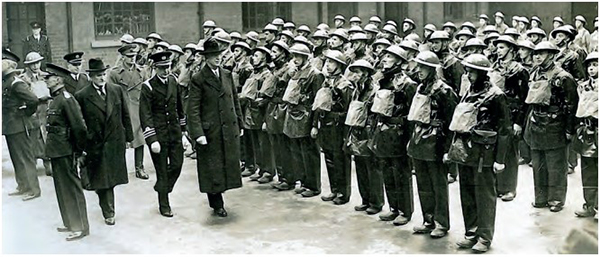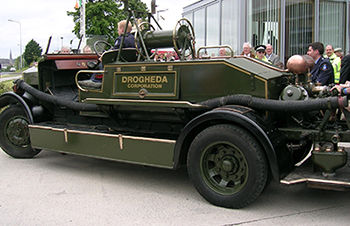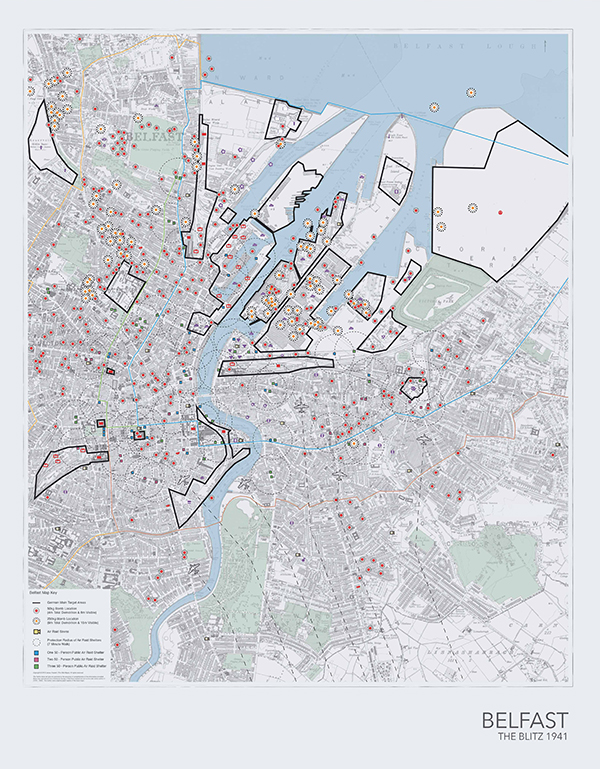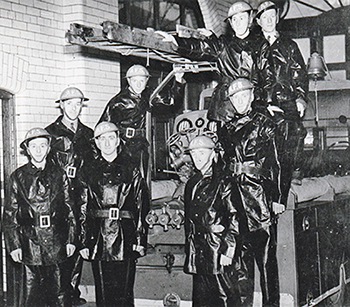When neutral Ireland’s emergency services went to war
Published in Features, Issue 3 (May/June 2021), Volume 29The response to the Belfast blitzes of 1941.
By Pat Poland
By April 1941 the United Kingdom had been at war with Nazi Germany for over a year and a half. From the start, the authorities in Northern Ireland believed that they were geographically too far removed from the main action for it to have any serious impact on them, a junior minister in the Northern Ireland cabinet declaring:
‘An attack on Northern Ireland would involve a flight of over 1,000 miles. For aeroplanes of the bombing type, loaded, this is a very big undertaking. The enemy aeroplanes must twice pass through the active gun, searchlight and aeroplane defences of Great Britain. It is possible that we might escape attack.’
Despite advice from the British government, efforts to evacuate children from Belfast to the country were lackadaisical. Some 70,000 children needed to be evacuated, but by the time of the first blitz on Belfast less than a tenth of that number had been taken out of the city. As one survivor later remarked, ‘We were living in cloud-cuckoo land’. That was all about to change. In May 1940, when Hitler’s massed Panzer divisions, with their unheard-of ‘lightning war’ tactics, invaded the Low Countries, the fall of France soon followed.
No longer would the Luftwaffe have to cross the North Sea, and Britain, to reach Northern Ireland. Bombers like the Junkers Ju88 and Heinkel He111, based in northern France, could now fly up the Irish Sea, well out of range of the land-based flak batteries, and bombard Northern Ireland. Thus on 7 April 1941 the people of Belfast were shocked when the first small surprise attack took place, targeting the Harland and Wolff shipyards and other industrial and commercial buildings in the area.
First major attack
On Easter Tuesday night, 15 April, a lone Belfast firefighter, high up in the drill tower of Fire Brigade headquarters in Chichester Street, was among the first to spot the oncoming Luftwaffe bombers. In the absence of an early-warning system such as radar, a firefighter, equipped with binoculars and a direct telephone to the control room, had been stationed at the top of the 70ft tower, at the time one of the tallest buildings in the city. He recalled the huge air armada being like a ‘swarm of insects’, wheeling in over Belfast Lough and turning, in a great arc, for the city. The distinctive ‘phut–phut–phut’ of the German engines left him in no doubt as to their origin. He picked up the phone.
At 10.40pm the air raid sirens sounded. Flying at less than 500ft (the usual flying height during a raid was 5,000–7,000ft), the Germans dropped some 300 flares to illuminate the city, the dazzling white lights serving to make it almost as bright as day. The anti-aircraft batteries, assisted by the guns of HMS Furious in dry dock, had at first put up a creditable barrage, but when the Central Telephone Exchange received a direct hit at around 1.45am the air defence control was disabled. After that the Luftwaffe had the skies to itself.
As the bomb-aimers peered down at the outline of the city far below, one of the first things they saw was the vast Belfast waterworks on the Antrim Road. Mistaking it for the docks area (which was, in fact, hidden under a defensive smokescreen), they rained down high explosives on the complex, mortally disabling the city’s firefighting water supply. Almost 700 high-explosive bombs fell during the ensuing five hours at a rate of two every minute; 90,000 incendiary bombs rained down on the city along with 76 land-mines, floating gently to the ground on their silk parachutes. Nearly 1,000 people would be killed in the blitz. Outside London, this represented the highest number killed in a single air raid in the United Kingdom; 56,000 homes were destroyed, rendering 100,000 people homeless. As the casualties began to overwhelm the medical services, the hospitals themselves came under attack. Incendiary bombs set alight the Mater Hospital, where Professor Theodore Thomson Flynn, head of ARP casualty services and father of screen heart-throb Errol Flynn, resolutely tried to restore some semblance of order to the chaos. Two other hospitals were destroyed. With the city’s water supply and most lines of communication out of action, the seven fire appliances of the regular Belfast Fire Brigade and the trailer pumps of the Auxiliary Fire Service (AFS) were rapidly overwhelmed. A state of emergency was declared.
At his home not far from the Stormont parliament building, John MacDermott, Minister for Public Security, ducked as explosions shook the house and shrapnel rattled along the roof tiles. Crouched under the desk in his study, he was relieved to discover that the railway telegram line to the south still worked. He now did something that no Northern Ireland minister had ever done before (or since): with the approval of Prime Minister Basil Brooke, he rang Dublin for help.

Above: Taoiseach Eamon de Valera—accompanied by Dublin Fire Brigade Chief Superintendent Major J.J. Comerford—inspects units of the Auxiliary Fire Service at Tara Street in April 1941. Behind the other hatted gentleman is Second Officer Val Walsh, the senior ranking fireman in charge of the southern units operating in Belfast. (Irish Independent)
Dev’s dilemma

Above: One of the restored 1940s Merryweather fire engines that made the two-and-a-half-hour trip to Belfast in April and May 1941 at the 75th commemoration in Drogheda on 15 May 2011. Note the lack of creature comforts and that it was completely open to the elements. (Joe Sheils)
At the outbreak of war, the Nazi Foreign Minister, Joachim von Ribbentrop, had informed the taoiseach that Éire had nothing to fear from Germany provided that it maintained a strict policy of neutrality. De Valera realised that by allowing units from southern fire brigades to reinforce those in the belligerent north—a war zone—he now risked incurring the wrath of the Germans and making southern cities targets themselves. Instinctively, however, he knew what he had to do. In possibly the quickest decision ever made in his long political career, he authorised the scrambling of the fire units.
In the early hours of the morning Major J.J. Comerford, Chief Superintendent of Dublin Fire Brigade, addressed the large parade of firefighters at headquarters in Tara Street. Quickly outlining the situation and delivering the message from the taoiseach, he looked for volunteers to go north, single men being preferred. After giving an assurance that the families of anyone who was maimed or killed would be looked after (the men would be operating outside the jurisdiction), the chief quickly filled his quota of volunteers. The Dublin mobile column would comprise regulars and AFS, while units from Dún Laoghaire, Dundalk and Drogheda would also take part—fourteen vehicles and almost 100 personnel in all. The Dundalk and Drogheda units, being that much closer to the north, were instructed not to wait for their Dublin and Dún Laoghaire colleagues but to respond without further delay. The senior officer in charge was Third Officer Richard Gorman.

All remembered the bitter cold. The engines used by the regulars, designed for urban use, were never intended for operating over long distances and were completely devoid of creature comforts. They were open to the elements, with the crew sitting along either side clutching a brass rail; some men later remembered having to sit on their hands, alternately, to stop them from freezing. The AFS men fared marginally better; their engines’ cabs were completely enclosed, with the crew’s compartment behind open at one side only. At the Killeen frontier post Customs waved them through and an RUC motorcycle escort was waiting for them.
New experience for southern firemen

Above: Members of the Dublin Auxiliary Fire Service in Thomas Street fire station after their return from Belfast in April or May 1941.
On arrival at Belfast Fire Brigade headquarters, the southern contingent were sent to tackle major fires in the docks and the general area of the Crumlin Road. They were joined by Second Officer Val Walsh of Dublin Fire Brigade, in overall command of the southern firemen. Fighting fires on such a massive scale was an altogether new experience for these men. Fireman John Kelly remembered ‘human bodies and dead animals lying all over the place’, and how shocked they were at the extent and scale of mutilation. Fireman Paddy Finlay of Rathmines station quickly climbed a fire ladder resting against a factory wall to reconnoitre the position from the top. While 50ft up, he noticed that the ladder was the sole support for the wall, and had only just completed a rapid descent when the entire structure collapsed.
Fireman Jim Dowling recalled speeding past a bombed-out public house on their way to their designated task when a man rushed out, flagging them down. They slowed momentarily and were dumbfounded to discover that the pub was being looted; the looters, far from departing, cheekily requested the firemen to cool down a safe that they had stashed in a corner. The request was curtly denied.
The Dún Laoghaire section was tasked with fighting a fire in a large factory. Battling the blaze from floor to floor, upon reaching the top storey they had a narrow escape from death. Sub-Officer Paddy White recalled how they ‘… heard the sound of the floor starting to groan and evacuated the area quickly. We had just cleared it when the entire floor collapsed with the heavy machinery crashing through the floors below.’
‘Return to base before nightfall’
Throughout that long day the southern firemen—grimy, thirsty and hungry—worked without respite at all the fires to which they were directed. That allowed their exhausted Belfast colleagues to snatch a few hours’ rest before returning to duty. Given the chaotic situation, no proper arrangements for feeding the men had been organised. In some instances grateful citizens shared their meagre rations with the firemen, but in many cases they simply did without. With the watery April sun sinking in the west, the southern firefighters, who had now been on continuous duty for over 35 hours (since 10am the previous day), received a directive from Dublin: ‘Return to base before nightfall’. The southern government, concerned at the political ramifications should the Germans return that night and an Irish firefighter be killed and assured by the Belfast authorities that all serious fires were in hand, had given the order to withdraw.
Eighteen days later, on 4 May, the Luftwaffe returned. This time the loss of life was less severe—150 killed—but the destruction of property was greater. As the fire service struggled to deal with two conflagrations, 22 major, 58 serious and 125 smaller fires, at 2am the Belfast fire chief made another distress call to his opposite number in Dublin. Again the taoiseach gave the order to scramble. A mobile column of fire appliances from the four southern brigades soon left for Belfast, this time accompanied by units of the St John Ambulance Brigade and the Irish Red Cross Society.
When German bombs fell on Dublin’s North Strand in late May, killing 34 people, severely wounding 90 and destroying or damaging 300 houses, the Belfast fire authorities were quick to offer assistance to their southern colleagues. Dublin Fire Brigade thanked them for their gracious offer but told them that they were able to cope.
The Northern Ireland authorities were grateful for the help afforded. Dr Magennis, parliamentary secretary, acknowledged the ‘very speedy, generous, and gallant help sent from Dublin, which was very much appreciated’, and Captain Ireland of the Ulster Unionist Club referred to Dublin as ‘the city that responded so nobly to the call of humanity in our time of need’. Others were less magnanimous. At the height of the Blitz, British Prime Minister Winston Churchill paid a surprise visit to the Home Office fire control room, situated deep in an underground fortress known as the ‘Rotunda’, not far from the Houses of Parliament. Shown around by the regional fire officer, Commander Sir Aylmer Firebrace, and studying the proceedings with great interest, he paused before a map of these islands and jabbed a stubby forefinger at Dublin, growling ‘Blot on democracy!’ before stomping out.
Pat Poland is the author of The Old Brigade: the Rebel City’s firefighting story, 1900–1950 (Oakroyd Publications, 2018).
FURTHER READING
B. Barton, The Belfast Blitz: the city in the war years (Belfast, 2015).
A.N.G. Firebrace, Fire Service memories (London, 1948).
R. Fisk, In time of war: Ireland, Ulster and the price of neutrality 1939–45 (London, 1983).
T. Geraghty & T. Whitehead, The Dublin Fire Brigade: a history of the brigade, the fires and the emergencies (Dublin, 2004).
















